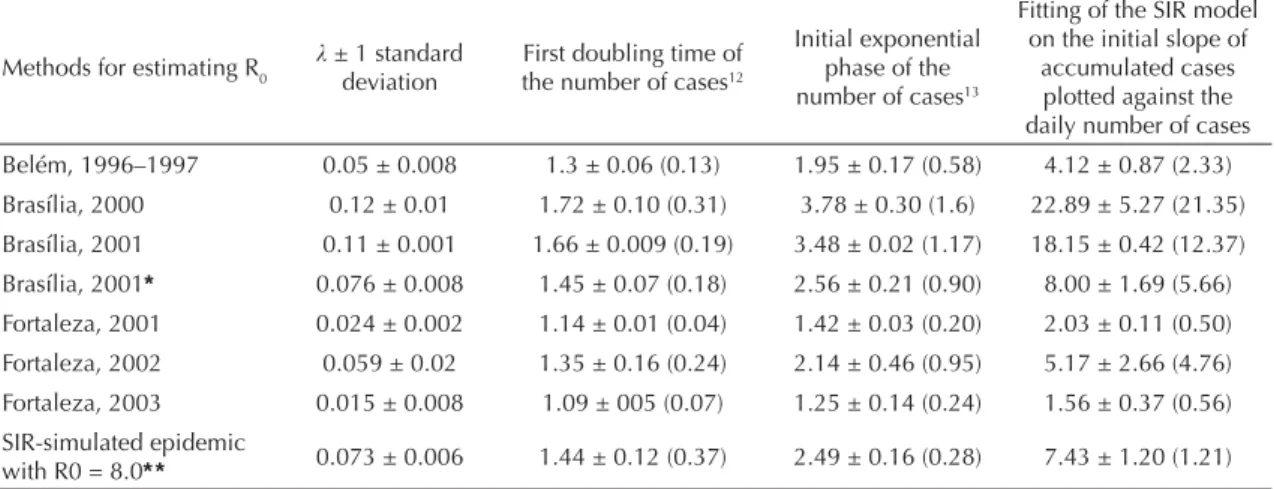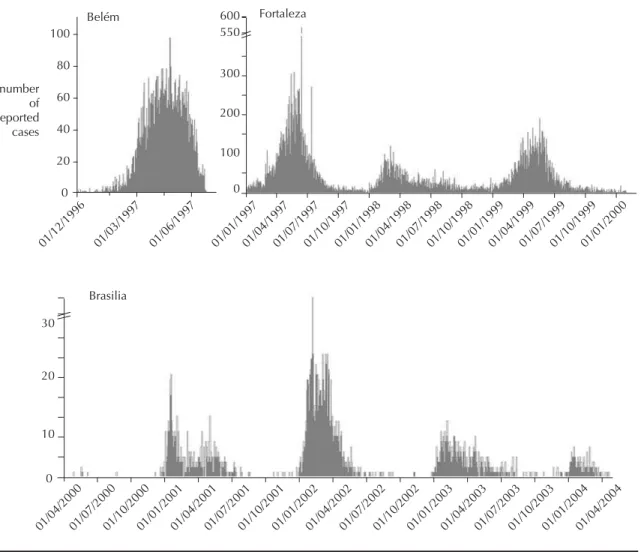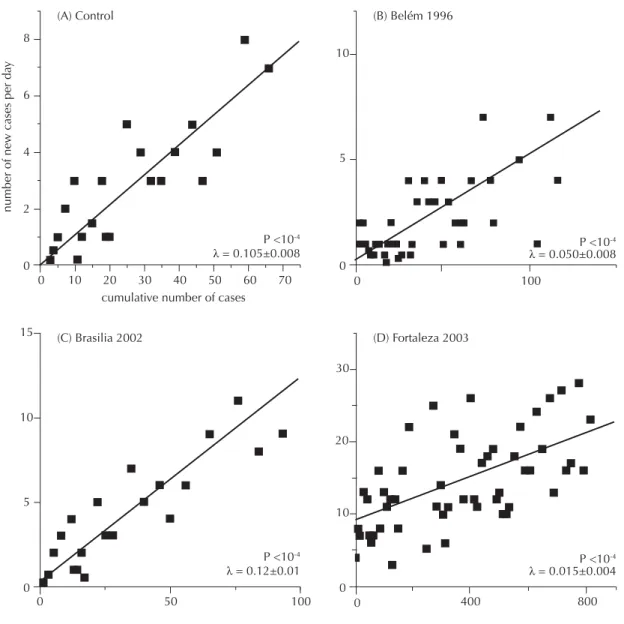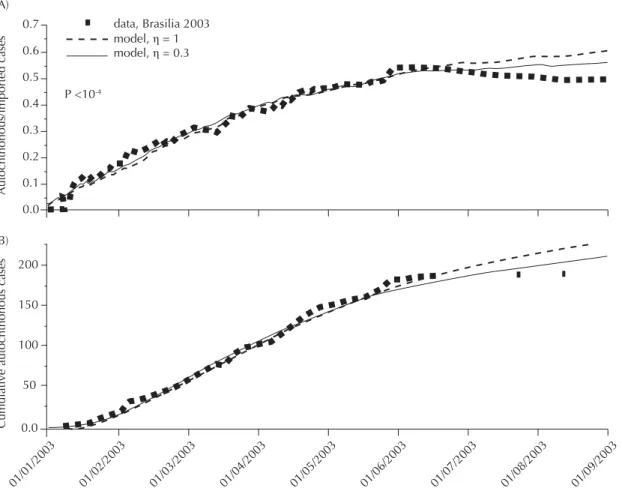Charly Favier
Jean-Philippe Boulanger
Christophe Menkes
Institut de Recherches pour le Développement. Paris, France
Correspondence:
Nicolas Degallier
Institut de Recherches pour le Développement LOCEAN-IPSL UPMC 4 pl. Jussieu case 100 T.45-55, 4eme étage
Faculté des Sciences, Paris 6 75252 Paris, France
E-mail: nicolas.degallier@ird.fr Received: 3/11/2008 Revised: 7/21/2008 Accepted: 9/16/2008
Imported and autochthonous
cases in the dynamics of
dengue epidemics in Brazil
Casos importados e autóctones na
dinâmica da epidemia de dengue no
Brasil
ABSTRACT
OBJECTIVE: To estimate the basic reproduction number (R0) of dengue fever including both imported and autochthonous cases.
METHODS:The study was conducted based on epidemiological data of the 2003 dengue epidemic in Brasília, Brazil. The basic reproduction number is estimated from the epidemic curve, fi tting linearly the increase of initial cases. Aiming at simulating an epidemic with both autochthonous and imported cases, a “susceptible-infectious-resistant” compartmental model was designed, in which the imported cases were considered as an external forcing. The ratio between R0 of imported versus autochthonous cases was used as an estimator of real R0.
RESULTS: The comparison of both reproduction numbers (only autochthonous versus all cases) showed that considering all cases as autochthonous yielded a R0 above one, although the real R0 was below one. The same results were seen when the method was applied on simulated epidemics with fi xed R0. This method was also compared to some previous proposed methods by other authors and showed that the latter underestimated R0 values.
CONCLUSIONS: It was shown that the inclusion of both imported and autochthonous cases is crucial for the modeling of the epidemic dynamics, and thus provides critical information for decision makers in charge of prevention and control of this disease.
Dengue fever has been endemic in Brazil since 1986.5 Its transmission involves only urban mosquitoes3 and humans, and many fatal cases occur every year due to epidemics where different serotypes are transmitted.8
The quick expansion of vectors and viruses throughout nearly all Brazilian states is facilitated by ever increas-ing movincreas-ing and travelincreas-ing of people in the country. Until recent years in most localities the origin of dengue cases was neither reported nor investigated. To the authors’ best knowledge, no study has been published investi-gating the impact of “imported” cases on the dynamics of the epidemics. The origin of each case in the 2002-2003 epidemics in Brasília was inferred after a detailed survey of the patient’s background, taking into account the duration of the incubation phase of the disease. As these data about the most probable origin of these cases were available, we investigated its possible impact on the dynamics of dengue epidemics. We compared its dynamics with the outputs of a simple “susceptible-infectious-resistant” (SIR) model modifi ed in order to include the input of daily numbers of imported cases when estimating the basic reproduction number (R0).
Mathematical modeling is a powerful tool to simulate real past situations, to input data from the present and hopefully to forecast future outcomes.6 It has been widely used to understand the dynamics of infectious
RESUMO
OBJETIVO: Estimar o número básico de reprodução da dengue (R0), com base nos casos importados, além dos casos autóctones.
MÉTODOS: O estudo foi feito sobre dados epidemiológicos da epidemia de dengue em Brasília, 2003. O número básico de reprodução é determinado a partir da curva epidêmica, ajustando uma reta ao crescimento inicial do número de casos. Para simular uma epidemia com casos autóctones e importados, foi criado um modelo compartimentado do tipo “suscetíveis-infectados-resistentes”. O R0 real foi estimado pela fração entre R0 dos casos autóctones e dos importados.
RESULTADOS: A comparação de ambos valores de reprodução (apenas autóctones versus todos os casos) mostrou que considerando todos casos como autóctones, o valor de R0 foi superior a um, enquanto o R0 real era inferior a um. O mesmo resultado foi obtido com o conjunto de dados simulando uma epidemia com R0fi xo. O método foi também comparado a outros, observando-se que estes últimos subestimaram os valores do R0.
CONCLUSÕES: A inclusão de tanto casos autóctones como os importados é essencial para modelar a dinâmica da epidemia, possibilitando informação crítica aos tomadores de decisão, responsáveis pelo controle da doença.
DESCRITORES: Dengue, epidemiologia. Infecções por Flavivirus, transmissão. Risco. Período de Transmissibilidade. Surtos de Doenças. Vigilância Epidemológica.
INTRODUCTION
diseases.1 A commonly used family of epidemiological models are the compartmental or “box ones”: individu-als are grouped in classes according to their immuno-logical status (e.g. SIR models consider the progress in the numbers of susceptible, infectious, and removed immune people).1 The basic reproduction number (R
0)
is an essential parameter to describe the dynamics of an outbreak. It is the number of secondary infections gen-erated by one case when the virus is introduced into a wholly susceptible population and when the probability of contact with the pathogen is homogeneous.7
The objective of the present study was to estimate the basic reproduction number (R0) of dengue fever inclu-ding both imported and autochthonous cases.
METHODS
Data analyzed refer to the dengue epidemics occurred during 2002–2003 in Brasília, Brazilian Federal Dis-trict (Figure 1). Brasília is a city situated in Central-West Brazil and has a rather recent history of contact with dengue.4
where m is the relative density of mosquitoes to hu-mans, a is the daily biting rate of the mosquitoes, b
and c are the probabilities of viral transmission from an infected mosquito to a susceptible human, and from an infected human to a mosquito, respectively, μ is the daily mortality rate of the vector,τe the extrinsic incubation period, and γ the inverse of the duration of viremia. In the present study, we modifi ed the method used by Massad et al13 (2001) to estimate the basic re-production number.2 Considering that the initial growth of the number of cases is exponential with parameter
λ, with τi the
intrinsic incubation period and the other parameters as above. Then, λ is estimated by a linear least squares
fi tting of the initial part of the curve of the cumulated number of cases against the daily number of new cases. The number of cases, which was taken into account for the regression of the increase at the beginning of each outbreak (slope λ in Fig. 2 A-D), was chosen to ensure a statistical signifi cance of p<10-4.
A simple SIR model is used to characterize the progress of local (autochthonous) cases with continuous infl ux of exogenous cases (imported). We set SA, IA and NA as susceptible, infectious and cumulative number of autochthonous cases, N as the total susceptible popula-tion and II and NI infectious and cumulative numbers of imported cases. The progress of NI is thus considered as an external forcing.
differences between the durations of exposure times of autochthonous and imported hosts, the latter arriving at various times of viremia. The basic reproductive rate of autochthonous cases is while for imported cases is is thus the ratio between the basic reproductive rate of imported and autochthonous cases. Since the fi nal number of autochthonous cases is far lesser than the whole population, the total number of people can be assumed very large (here N = 100,000) and, as we only consider the initial model behavior, results are independent of N provided it is large enough. The other two parameters are computed by a fi t of the ratio between the cumulative autochtho-nous cases over the cumulative imported cases in the Nelder-Mead simplex algorithm pre-implemented using MATLAB. Using this index (the ratio between autoch-thonous and imported cumulative cases) for the fi t has yielded results that were more robust to the initial guess than the cumulative number of autochthonous cases. Bootstrap methods were used to estimate confi dence intervals and R0s values were compared to R0 estimated as if all cases were autochthonous.
RESULTS
In the case of the 2003 dengue epidemic in Brasília, the imported cases were included, and the modifi ed model fi tted when only autochthonous cases were con-sidered (Figure 3B), as well when autochthonous cases were divided by the daily numbers of imported cases (Figure 3A). The comparison of R0 estimated using the method above (when the number of imported cases is unknown or disregarded) with R0 estimated when
Table 1. Estimates of the initial slope of the fi tted curve ( ) and R0 with standard error, according to various methods, for the
epidemics in Brasília (Federal District), Belém (Northern Brazil) and Fortaleza (Northeastern Brazil).
Methods for estimating R0 ± 1 standard deviation
First doubling time of the number of cases12
Initial exponential phase of the number of cases13
Fitting of the SIR model on the initial slope of
accumulated cases plotted against the daily number of cases Belém, 1996–1997 0.05 ± 0.008 1.3 ± 0.06 (0.13) 1.95 ± 0.17 (0.58) 4.12 ± 0.87 (2.33) Brasília, 2000 0.12 ± 0.01 1.72 ± 0.10 (0.31) 3.78 ± 0.30 (1.6) 22.89 ± 5.27 (21.35) Brasília, 2001 0.11 ± 0.001 1.66 ± 0.009 (0.19) 3.48 ± 0.02 (1.17) 18.15 ± 0.42 (12.37) Brasília, 2001* 0.076 ± 0.008 1.45 ± 0.07 (0.18) 2.56 ± 0.21 (0.90) 8.00 ± 1.69 (5.66) Fortaleza, 2001 0.024 ± 0.002 1.14 ± 0.01 (0.04) 1.42 ± 0.03 (0.20) 2.03 ± 0.11 (0.50) Fortaleza, 2002 0.059 ± 0.02 1.35 ± 0.16 (0.24) 2.14 ± 0.46 (0.95) 5.17 ± 2.66 (4.76) Fortaleza, 2003 0.015 ± 0.008 1.09 ± 005 (0.07) 1.25 ± 0.14 (0.24) 1.56 ± 0.37 (0.56) SIR-simulated epidemic
with R0 = 8.0* * 0.073 ± 0.006 1.44 ± 0.12 (0.37) 2.49 ± 0.16 (0.28) 7.43 ± 1.20 (1.21) * In the case of the 2001 Brasília epidemic, calculations have also been done considering the total number of cases as if their imported vs. autochthonous nature were unknown, thus allowing the comparison with the method which includes imported cases.
* * The SIR epidemic have been obtained by simulation, and served as control with fi xed value of R0. Between parenthesis are the standard error when variation was added to the model parameters. The following values were taken from McBride & Bielefeldt-Ohmann14 (2000): = 0.1 ± 0.05; infectious viremic period = 6 ± 1 days; = 0.166 ± 0.027; τ
exogenous cases are explicitly included is striking. In the fi rst case, R0 is far greater than one, indicating eco-epidemiological conditions favorable to local transmission of the virus. In the second case, the lo-cal R0 (estimated for autochthonous transmission) is clearly lower than one. The results of the comparison between the three methods are shown in Table 1, for different epidemics and for a SIR-simulated one with pre-defi ned R0 = 8.0. Besides great variability between the epidemics, the R0 values estimated by the method here described are always greater than those obtained using other methods. Furthermore, this method is the only one that provides a correct estimation of the R0 of the SIR-modeled epidemic. Figure 4 shows an almost linear relationship between R0aut and R0imp, when the former is set under one. Thus, under such assumptions, it becomes evident that in case of an epidemic, the reproduction number due to imported cases cannot be above 0.45 and that if the reproduc-tion number due to autochthonous cases is near one, the latter becomes negligible.
DISCUSSION
The methods used by Marques et al12 (1994) and Massad et al13 (2001) systematically underestimated R0, probably because they failed to consider the whole delay between two successive cases (viremia, and intrinsic and extrinsic incubation periods). The dif-ferences between the R0 values obtained for different epidemics (Table 1) refl ect various eco-epidemiologi-cal conditions infl uencing hidden parameters (such as mosquito density, effective exposure rates between hosts and vectors10).
Except for the viremic period in infected people, these parameters vary with climatic factors, mainly tempera-ture and relative humidity, which affect vector survival and virus extrinsic cycle. Other factors may infl uence R0 but are generally not addressed due to unavailability of relevant data such as the degree of urbanization and social structure,11 transmission history and/or immune status of human population. The human population is no more fully susceptible in most Brazilian cities, and the 100
80
60
40
20
0
10 20 30
0
600 Fortaleza Belém
Brasilia number
of reported cases
550
300
200
100
0
01/01/200401/04/2004 01/10/2003
01/07/2003 01/04/2003 01/01/2003 01/10/2002 01/07/2002 01/04/2002 01/01/2002 01/10/2001 01/07/2001 01/04/2001 01/01/2001 01/10/2000 01/07/2000 01/04/2000
01/01/2000 01/10/1999 01/07/1999 01/04/1999 01/01/1999 01/10/1998 01/07/1998 01/04/1998 01/01/1998 01/10/1997 01/07/1997 01/04/1997 01/01/1997 01/12/1996 01/03/1997 01/06/1997
case of Belém (Northern Brazil) was an exception since the 1997–1998 epidemic was the fi rst in this city.16 In the cases of Brasília and Fortaleza (Northeastern Brazil) epidemics, where dengue transmission is known since 1997 and 1986, respectively,4,a our R
0 values are thus probably underestimated. As illustrated by Keeling & Grenfell9 (2000), assumptions about case distribution are rarely met in natural situations, and the assumption of homogeneity of contact is also generally not met, as it has been previously shown that cases are often ag-gregated inside and around the houses of the fi rst cases. This may also contribute to underestimating R0 values.
An unknown proportion of cases remain undetected as they are asymptomatic or are diagnosed as other fever-causing diseases. This fact makes the determination of the number of cases uncertain but not the estimation of R0 if we postulate that it is independent of the intensity of symptoms. A similar, or even more serious diffi culty is the number of uncharacterized imported cases, which may negatively affect the estimation of R0 and thus invalidate any decision about prevention and control. This clearly implies that dengue epidemics may occur even when local ecological conditions are unfavorable, as was probably the case in Brasília in 2003. This is
number of new cases per da
y
cumulative number of cases 0
0 2 4 6 8
10 20 30 40 50 60
P <10-4
λ = 0.105±0.008
70 0
0 5 10
100
P <10-4
λ = 0.050±0.008
(C) Brasilia 2002
0 0 5 10 15
50
P <10-4
λ = 0.12±0.01
100
(D) Fortaleza 2003
0 0 10 30
20
400 800
P <10-4
λ = 0.015±0.004
Figure 2. Estimation of R0 including only the autochthonous cases or the total number of cases when the number of imported ones was not known. (A) Simulated epidemic, obtained by the SIR model where R0 was set at 8.4 (see methods), (B) Belém
(Northern Brazil) 1996 epidemic, (C) Brasília (FD), 2002 epidemic, and (D) Fortaleza (Northeastern Brazil), 2003 epidemic. The number of cumulative cases used to estimate R0 was chosen for p<10-4; is the slope of the regression curve.
a Degallier N, Hervé J-P, Travassos da Rosa APA, Travassos da Rosa ES, Vasconcelos PFC, Monteiro HAO, Sá Filho G, Travassos da Rosa JFS. Entomological studies on dengue fever vectors in Brazil: the epidemics of Boa Vista, Roraima, 1982, Niterói, Rio de Janeiro, 1986, and Ceará State, 1986, 1994. In: Travassos da Rosa APA, Vasconcelos PFC, Travassos da Rosa JFS. An overview of arbovirology in Brazil and neighbouring
the fi rst report emphasizing this aspect. Taking into account the imported vs. autochthonous nature of each diagnosed case will allow a better evaluation of the risk of dengue transmission or epidemic. Health authorities involved with dengue monitoring and prevention should develop and strengthen their methods to determine the imported or autochthonous origin of the cases. Future studies should incorporate these data in models, along with the yet missing entomological fi eld data. As the populations of arthropod vectors are much infl uenced by climatic factors, it may thus be possible to link the dynamics of outbreaks to climatic factors through the underlying R0 and vectorial capacity.
ACKNOWLEDGEMENTS
Cristiane Oliveira of Diretoria de Vigilância Ambiental de Brasília, Brazil; José Rubens Costa Lima of Célula de Vigilância Epidemiológica de Fortaleza, Brazil; and Bernard Mondet of Institut de Recherche pour le Développement, Montpellier, France provided the data on epidemics of dengue from Brasília, Fortaleza and Belém, respectively.
P <10-4 0.7
0.6
0.5
0.4
0.3
0.2
0.1
0.0
data, Brasilia 2003 (A)
(B)
model, η = 1
Autochthonous/imported cases
model, η = 0.3
Cumulative autochthonous cases
200
150
100
50
0.0
01/09/2003 01/08/2003
01/07/2003 01/06/2003
01/05/2003 01/04/2003
01/03/2003 01/02/2003
01/01/2003
Figure 3. Fitting of the modifi ed SIR model (with imported cases included) with the initial cumulative curve of daily numbers of autochthonous cases (B), and daily ratio of autochthonous / imported cases (A) in Brasília, DF, 2003. Best-fi t model was obtained with = 0.04 and = 0.015 for η = 1 and with = 0.07 and = 0.048 for η = 0.3 (ηis the ratio between the basic reproductive rate of imported cases and the rate of autochthonous cases).
Figure 4. Relationships between imported and autochthonous cases during the 2002 epidemic in Brasília, FD, Brazil. R0I and R0A were both set below one, with R0I≤ R0A, and the R0A/R0I ratio was set at various values from 1 to 0.2. Error bars represents the 0.95 confi dence interval.
1.1
1.0
0.9
0.9
0.7
0.6
0.5
0.4
0.3
0.2
0.1
0.00 0.05 0.10 0.15 0.20 R0 imp R0 aut
1. Anderson RM, May RM. Infectious diseases of humans: dynamics and control. Oxford: Oxford University Press; 1999.
2. Degallier N, Favier C, Boulanger JP, Menkes CE, Oliveira C. Une nouvelle méthode d’estimation du taux de reproduction des maladies (Ro): application à l’étude des épidémies de Dengue dans le District Fédéral, Brésil. Environ Risq Sante. 2005;4(2):131-5. 3. Degallier N, Teixeira JMS, Soares SS, Pereira RD,
Pinto SC, Chaib AJ, Vasconcelos PF, Oliveira E.
Aedes albopictus may not be transmitting dengue virus to man during epidemics in Brazil. Rev Saude Publica. 2003;37(3):386-7. DOI: 10.1590/S0034-89102003000300019
4. Degallier N, Teixeira JM, Vilarinhos PD, Pinto SC, Pereira RD. First isolation of dengue 1 virus from
Aedes aegypti in Federal District, Brazil. Rev Soc Brasil Med Trop. 2000;33(1):95-6. DOI: 10.1590/S0037-86822000000100016
5. Degallier N, Travassos da Rosa APA, Vasconcelos PFC,
etal.La dengue et ses vecteurs au Brésil. Bull Soc Path Ex. 1996;89:128-36.
6. Dietz K. Transmission and control of arbovirus diseases. In: Ludvig D, Cooke KL. Proceedings of SIMS Conference on Epidemiology; 1974 July 8–12; Alta, United States. 1974. p.104-21.
7. Dietz K. The estimation of the basic reproduction number for infectious diseases. Stat Methods Med Res.
1993;2(1):23-41. DOI: 10.1177/096228029300200103 8. Halstead SB. Observations related to pathogenesis
of dengue hemorrhagic fever. VI. Hypotheses and discussion. Yale J Biol Med. 1970;42:350-62.
9. Keeling MJ, Grenfell BT. Individual-based perspectives on R(0). J Theor Biol. 2000;203(1):51-61. DOI: 10.1006/jtbi.1999.1064
10. Kuno G. Review of the factors modulating dengue transmission. Epidemiol Rev. 1995;17(2):321-35. 11. Kuno G. Factors infl uencing the transmission of dengue
viruses. In: Gubler DJ, Kuno G. Dengue and Dengue Hemorrhagic Fever. Wallingford: CAB International 1997. p.61-88.
12. Marques CA, Forattini OP, Massad E. The basic reproduction number for dengue fever in São Paulo state, Brazil, 1990-1991 epidemic. Trans R Soc Trop Med Hyg. 1994;88(1):58-9. DOI: 10.1016/0035-9203(94)90498-7
13. Massad E, Coutinho FA, Burattini MN, Lopez LF. The risk of yellow fever in a dengue infested area. Trans R Soc Trop Med Hyg. 2001;95(4):370-4. DOI: 10.1016/ S0035-9203(01)90184-1
14. McBride WJ, Bielefeldt-Ohmann H. Dengue viral infections: pathogenesis and epidemiology. Microbes Infect. 2000;2(9):1041-50. DOI: 10.1016/S1286-4579(00)01258-2
15. Nájera JA. A critical review of the fi eld application of a mathematical model of malaria eradication. Bull World Health Organ. 1974;50(5):449-57.
16. Travassos da Rosa JFS, Mahagama AK, Pinto E, Magalhães MTF. Epidemia de dengue na grande Belém: aspectos conceituais e abordagem clínico-epidemiológica, no ano de 1997. Rev Soc Bras Med Trop. 1998;31(Supl):130.
Study fi nancially supported by IRD-UMR182 (France), and National Health Foundation – Ministry of Health (Brazil). C. Favier was supported by the Project Modélisation des Arboviroses Tropicales Emergentes CLImato-Dépendantes (MATECLID; post graduate grant, Process APR GICC 2002).



